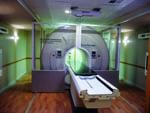
Gordon L. Grado, M.D., opened two radiation oncology centers in Mexico, introducing the first TomoTherapy units to the country.
Cancer doesn’t discriminate by gender, age or where a person resides. But in many cases, the quality of care a patient receives can depend on where they live. For patients who live in rural areas or far from major cities with premier cancer treatment centers and research universities, the barriers to getting access to cutting-edge care can be almost insurmountable.
Over the past few years, we have seen new technological advances break down barriers to quality care, but one of the more remarkable innovations may be in radiation therapy (RT).
Until recently, only brachytherapy or diagnostic imaging, such as portable magnetic resonance imaging (MRI), positron emission tomography (PET) or computed tomography (CT) systems, could be transported to remote locations. However, linear accelerators can now be housed in a mobile unit and taken to a hospital or medical center where the need is the greatest.
This model is unique to the field of radiation oncology in that the entire radiation therapy system — which includes imaging, sophisticated treatment planning technology and radiation delivery — is compact enough to fit into a customized, movable coach. This relocatable radiation therapy solution now enables doctors to bring advanced cancer treatments right to patients, no matter where they live.
A New Business Model
Similar to mobile diagnostic imaging or brachytherapy units, mobile radiation therapy is designed to provide patients in remote areas access to the same quality of care as they would receive in large metropolitan areas. Additionally, it provides a new business model for facilities looking to expand their services with radiation therapy.
Because of its standard design, it can be up and running to treat patients in a matter of days, rather than the months or even years it may take to build a brick-and-mortar facility and install a system in a vault. This is very important to medical oncologists and their patients, because waiting a year to have access to this type of care is not acceptable.
The solution can be moved in as a temporary treatment solution, while new facilities are being built or in advance of a permanent system installation. This enables the cancer treatment center to begin offering treatments quickly in order to establish a patient base and even generate revenue to help fund construction of the permanent center.
Another advantage of the mobile treatment center is that it can be brought into any market where a clinic has more patients that require treatment than it can handle with its existing radiation therapy system. The equipment’s quick deployment time allows radiation oncologists to alleviate temporary backlogs in a cost-effective manner and eliminate the issue of having to turn patients away.
And finally, mobile radiation therapy can be used as a permanent option at centers that have no additional interior space to expand their facilities. The interior of the TomoMobile is just like a new, modern treatment center. It is designed for patient comfort and staff usability, so it doesn’t have the feel of something that is temporary or impersonal.
Tomotherapy Technology
Marking a first in radiation therapy, Tomotherapy Inc. debuted the TomoMobile at the 2009 American Society for Radiation Oncology (ASTRO) annual meeting, and plans to start up the system in Yuma, Ariz.
While the TomoMobile exclusively deploys Tomotherapy’s proprietary technology, it is a unique model for other types of modalities. The system is a fully integrated, ring gantry-based system, which combines a CT scanner and a linear accelerator for the delivery of image-guided, intensity-modulated adaptive radiation therapy (IG-IMRT).
With imaging built into the therapy system, clinicians are able to create daily 3D CT imaging of patients to ensure accurate delivery of highly precise treatment plans. The system’s helical radiation delivery capabilities are designed to enable continuous delivery of radiation treatments from all angles around the patient and conform to the shape of both simple and complex tumors.
Radiation shielding enables the technology to be safely housed in the mobile unit, without damaging outside surrounding buildings and structures. An integrated beam stop, which when used in traditional vault-based deployments, requires less external shielding than other radiation therapy solutions. As a result, when the Tomotherapy system is installed in the movable coach, the required shielding can be transported in separately.
The platform also integrates software for treatment planning, quality assurance, patient set-up, and treatment delivery into the same centralized database. By storing all patient and plan information in a single location, physicians can ensure the validity of all patient treatment plan data. The IT also enables users to consult with colleagues and share dosimetry reports and other patient information with physicists and dosimetrists located around the country.
Improving Cancer Care in Under-Served Markets
For years, a radiation oncology practice in Glendale and Scottsdale, Ariz., has been working with an oncology practice located in Yuma, Ariz., a city with 100,000 residents located roughly 200 miles southwest of Phoenix. Although the Yuma site offers radiation therapy services, the medical oncology practice routinely sends patients to the treatment centers to receive treatment using tomotherapy technology. As a result, their patients had to travel more than three-and-a-half hours from home and find hotel accommodations throughout the course of their treatments.
With the debut of TomoMobile at the Yuma site, a new option in cancer care can be efficiently and cost-effectively brought to areas like Yuma.
At the facility in Yuma, the mobile unit will provide IGRT/IMRT radiation therapy. The solution will be used to treat all types of cancers, including some of the most difficult cases, such as patients who have recurrences after conventional radiation, local control issues or multiple tumors throughout their body.
The Yuma practice is planning to use the mobile radiation therapy until it builds a new facility and installs its own tomotherapy linear accelerator. Eventually, the mobile unit will serve other under-served regions, providing the level of care all patient populations need and deserve.



 December 11, 2025
December 11, 2025 









